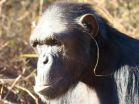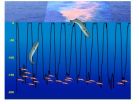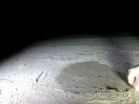(Press-News.org) Chimpanzees are copycats and, in the process, they form new traditions that are often particular to only one specific group of these primates. Such are the findings of an international group of scientists, who waded through over 700 hours of video footage to understand how it came about that one chimpanzee stuck a piece of grass in her ear and started a new trend, and others soon followed suit. The findings of the study, led by Edwin van Leeuwen of the Max Planck Institute for Psycholinguistics in The Netherlands, are published in Springer's journal Animal Cognition.
In 2010, van Leeuwen first noticed how a female chimp named Julie repeatedly put a stiff, strawlike blade of grass for no apparent reason in one or both of her ears. She left it there even when she was grooming, playing or resting in Zambia's Chimfunshi Wildlife Orphanage Trust sanctuary. On subsequent visits, van Leeuwen saw that other chimpanzees in her group had started to do the same.
This aroused his interest to find out if they copied what Julie did by watching and learning from her through so-called social learning. The research team, including Zambians who monitor the chimpanzees daily, collected and analyzed 740 hours of footage that had been shot during the course of a year of 94 chimpanzees living in four different social groups in the sanctuary. Only two of these groups could see one another.
The research team found that only one of the four groups regularly performed this so-called "grass-in-the-ear" behavior. In one other group one chimpanzee once did the same. Eight of the twelve chimpanzees in Julie's group repeatedly did so. The first to copy her was her son, Jack, followed by Kathy, Miracle and Val with whom she regularly interacted. Generally at least two of the chimps put grass in their ear at the same time. Interestingly, the chimpanzees Kathy and Val kept up the custom even after Julie, the original inventor of this behavior, died.
The observations show that there's nothing random about individual chimpanzees sticking grass into their ears. They spontaneously copied the arbitrary behavior from a group member. Chimpanzees have a tendency to learn from one another – clearly a case of "monkey see, monkey do" in fact. Van Leeuwen suggests that those animals that find a specific behavior somehow rewarding will continue to do so on their own, even if the chimpanzee they have learned it from is no longer around.
"This reflects chimpanzees' proclivity to actively investigate and learn from group members' behaviors in order to obtain biologically relevant information," says van Leeuwen. "The fact that these behaviors can be arbitrary and outlast the originator speaks to the cultural potential of chimpanzees."
INFORMATION:
Reference: Van Leeuwen, E.J.C. et al (2014). A group-specific arbitrary tradition in chimpanzees (Pan troglodytes), Animal Cognition. DOI 10.1007/s10071-014-0766-8
The full-text article, videos and photos are available to journalists on request.
'Grass-in-the-ear' technique sets new trend in chimp etiquette
Chimpanzees spontaneously copy arbitrary behavior of other members of their social group
2014-07-03
ELSE PRESS RELEASES FROM THIS DATE:
GW researchers: Acute kidney injury and chronic kidney disease as interconnected syndromes
2014-07-03
WASHINGTON (July 3, 2014) — For more than 40 years, physicians have treated diminished kidney function as two distinct syndromes: acute kidney injury (AKI) and chronic kidney disease (CKD). However, recent epidemiologic and mechanistic studies suggest the two syndromes are not distinct entities, but interconnected. Published today in The New England Journal of Medicine, George Washington University (GW) researchers call for greater follow-up care of patients with AKI, who often present with CKD later in life, and vice versa.
"Our teaching has been wrong and the approach ...
Weighing up the secrets of African elephant body fat
2014-07-03
A research team from The University of Nottingham has carried out the first molecular characterisation of the African elephant's adipose tissue — body fat. This new information will form the basis of future studies aimed at securing the health and future survival of captive elephants.
The population of captive elephants, both Asian and African, in Europe and North America is not self-sustaining, largely due to poor fertility, resulting in a fewer baby elephants being born. It is acknowledged that if a solution for these reproductive difficulties cannot be found quickly, ...
Identifying microbial species
2014-07-03
Millions of microbial species populate the world, but so far only a few have been identified due to the inability of most microbes to grow in the laboratory. Edgar Goluch, an engineer, and Slava Epstein, a biologist, aim to change this. The pair, both researchers at Northeastern University, has developed a device that allows scientists to cultivate a single species of bacteria that can then be studied and identified.
Goluch's previous research devices incorporated permeable membranes that allow sequestered bacteria to be exposed to the nutrients and molecules of their ...
Women veterans want options, follow up support when dealing with intimate partner violence
2014-07-03
(Boston)--Intimate partner violence (IPV) is a significant health issue faced by women veterans, but little has been known up until now about their preferences for IPV-related care. A new study has found that most of these women support routine screening for IPV and want options, follow-up support, transparent documentation and Veterans Health Administration (VHA) and community resources. These findings appear in the journal Research in Nursing and Health.
Although women of all socio-demographic groups are at risk for IPV, population-based research suggests that women ...
Hot Pot with chicken causes campylobacter infections in Switzerland
2014-07-03
This news release is available in German and French. In Switzerland, between 7000 and 8000 persons fall ill with a campylobacter infection annually. This makes it the most frequent bacterial disease transmitted through food. Contamination of chicken meat with campylobacter bacteria during the slaughtering process is one of the known causes of the infection. An increase of campylobacteriosis case numbers is being observed throughout Europe. Human cases of campylobacteriosis must be reported to the relevant authorities in Switzerland.
In Switzerland, an unusual increase ...
Low brain protein levels associated with neurodegeneration
2014-07-03
Persons with reduced levels of the TREM2 protein could be at greater risk of developing neurodegenerative diseases such as Alzheimer's disease or frontotemporal dementia, according to an international study which included the participation of the Universitat Autònoma de Barcelona and the Sant Pau Biomedical Research Institute (IIB Sant Pau).
The study, published in Science Translational Medicine, reveals the molecular mechanism by which the mutated forms of this protein prevent the amyloid waste cleaning process from functioning correctly and detects a lower level of ...
Whales as ecosystem engineers
2014-07-03
"Consider the subtleness of the sea; how its most dreaded creatures glide under water, unapparent for the most part," wrote Herman Melville in Moby Dick. Today, we no longer dread whales, but their subtlety remains. "For a long time, whales have been considered too rare to make much of a difference in the oceans," notes University of Vermont conservation biologist Joe Roman. That was a mistake.
In a new paper, Roman and a team of biologists have tallied several decades of research on whales from around the world; it shows that whales, in fact, make a huge difference—they ...
No two lark sparrows are alike (at least when it comes to migration habits)
2014-07-03
A new paper by Dr. Jeremy Ross from the University of Oklahoma describes the use of tiny devices strapped to birds' backs called geolocators, which capture the individual migration routes of lark sparrows in North America. By sensing the light levels, these backpacks can pinpoint the location of a bird anywhere in the world, even if retrieving the data-logger can sometimes pose a major problem.
This study, published in the online journal Animal Migration, mapped for the first time the routes traveled by three lark sparrows after they left their breeding grounds in Ohio. ...
Consider water use in climate change policies, advise Australian researchers
2014-07-03
There's more to trying to slow down climate change than just cutting greenhouse gas emissions. Technology, policies or plans that aim to do so should also take environmental factors such as water usage into account. A more integrated approach might make some options considerably more attractive than others, especially when implemented in arid countries such as Australia, advise Philip Wallis of Monash University in Australia and colleagues, in an article in Springer's journal Climatic Change.
The researchers considered the example of Australia to show how water usage ...
Jump to it! A frog's leaping style depends on the environment
2014-07-03
VIDEO:
Tree frogs reach great heights with their jumps, but do not cover much distance.
Click here for more information.
A frog's jump is not as simple as it seems....Australian scientists have discovered that different species adopt different jumping styles depending on their environment.
Lead researcher, Miss Marta Vidal-Garcia ( PhD candidate, Australian National University ), found that tree dwelling frogs reached great heights but didn't cover much distance with their ...
LAST 30 PRESS RELEASES:
Numbers in our sights affect how we perceive space
SIMJ announces global collaborative book project in commemoration of its 75th anniversary
Air pollution exposure and birth weight
Obstructive sleep apnea risk and mental health conditions among older adults
How talking slows eye movements behind the wheel
The Ceramic Society of Japan’s Oxoate Ceramics Research Association launches new international book project
Heart-brain connection: international study reveals the role of the vagus nerve in keeping the heart young
Researchers identify Rb1 as a predictive biomarker for a new therapeutic strategy in some breast cancers
Survey reveals ethical gaps slowing AI adoption in pediatric surgery
Stimulant ADHD medications work differently than thought
AI overestimates how smart people are, according to HSE economists
HSE researchers create genome-wide map of quadruplexes
Scientists boost cell "powerhouses" to burn more calories
Automatic label checking: The missing step in making reliable medical AI
Low daily alcohol intake linked to 50% heightened mouth cancer risk in India
American Meteorological Society announces Rick Spinrad as 2026 President-Elect
Biomass-based carbon capture spotlighted in newly released global climate webinar recording
Illuminating invisible nano pollutants: advanced bioimaging tracks the full journey of emerging nanoscale contaminants in living systems
How does age affect recovery from spinal cord injury?
Novel AI tool offers prognosis for patients with head and neck cancer
Fathers’ microplastic exposure tied to their children’s metabolic problems
Research validates laboratory model for studying high-grade serous ovarian cancer
SIR 2026 delivers transformative breakthroughs in minimally invasive medicine to improve patient care
Stem Cell Reports most downloaded papers of 2025 highlight the breadth and impact of stem cell research
Oxford-led study estimates NHS spends around 3% of its primary and secondary care budget on the health impacts of heat and cold in England
A researcher’s long quest leads to a smart composite breakthrough
Urban wild bees act as “microbial sensors” of city health.
New study finds where you live affects recovery after a hip fracture
Forecasting the impact of fully automated vehicle adoption on US road traffic injuries
Alcohol-related hospitalizations from 2016 to 2022
[Press-News.org] 'Grass-in-the-ear' technique sets new trend in chimp etiquetteChimpanzees spontaneously copy arbitrary behavior of other members of their social group



